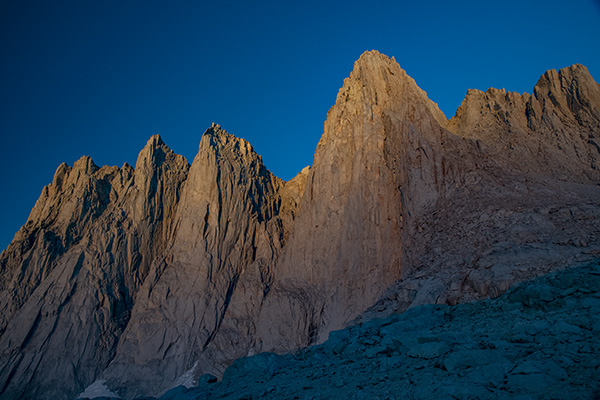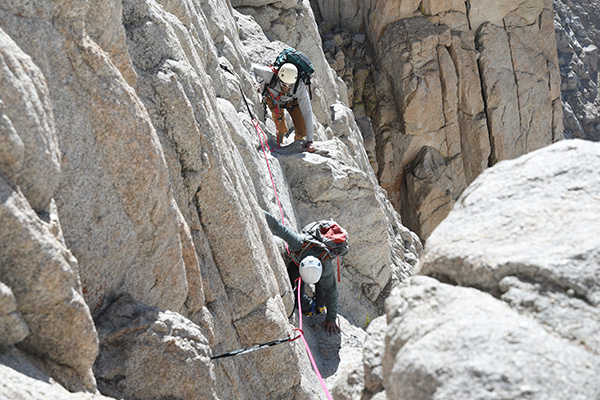
Rock climbing Mt. Whitney via the classic East Face and East Buttress routes!
Rock climbing Mt. Whitney is an opportunity to ascend the highest peak in the contiguous United States via a route seen by relatively few people who visit this region. Mt. Whitney is the most popular of all the mountains SMI conducts trips to, and for good reason. Magnificent scenery and it’s setting along the crest of the Sierra along with its lofty elevation make this climb an unforgettable experience. The East Face and East Buttress routes are tremendous alpine rock climbs and the fact that they lead to the summit of Mt. Whitney make them all the more attractive.
The Approach: Hiking to Iceberg Lake
The journey begins at Whitney Portal (8350’/2545m). After final gear checks and loading rucksacks the team sets off for the North Fork of Lone Pine Creek. This “climbers trail” passes pine trees, willows, abundant wildflowers, and the Ebersbacher Ledges as it ascends a canyon that tops out at Lower Boy Scout Lake (10350’/3155m). The route continues past Upper Boy Scout Lake (11000’/3353m) to a mid afternoon arrival at Iceberg Lake (12610’/3844m) after approximately 6 hours of hiking. After making camp and an early dinner it’s time to bed down in the waning light so the team is ready for an early start to climb the East Face of Mt. Whitney.
The East Face of Mt. Whitney
Rising ahead of sunrise affords getting a jump on the day to maximize daylight. It also offers a stunning view of the Mt. Whitney massif bathed in glowing morning light reminding onlookers why the Sierra is nicknamed the Range of Light. A 45 minute hike over easy 3rd class terrain leads to the start of the route. Clothing layers are adjusted, sunscreen applied, harnesses are donned and climbers tie into the rope. This route is normally 11 pitches long with the hardest moves rated at 5.7, but it is not sustained climbing at this grade.


Rock climbing Mt. Whitney: The Tower Traverse
The first pitch rock climbing Mt. Whitney via the East Face is the Tower Traverse. This exhilarating start to the route entails traversing a ledge that leads to a small corner/chimney system, which is ascended for about 25 feet to the first belay station.

Rock climbing Mt. Whitney: The Fresh Air Traverse
Above the Tower Traverse the route ascends a prominent ramp known as the Washboards, which is mostly 3rd and 4th class. A short blocky pitch then leads to a tower that is down climbed to a large ledge at the base of the Fresh Air Traverse.
The Fresh Air Traverse is considered by many to be the highlight of the East Face route. A “step across” over a fantastic stretch of exposure on good holds marks the crux moves, which is followed by climbing a series of ledges. Solid hold on high quality granite combined with over 1000′ view below make negotiating the Fresh Air Traverse a truly exhilarating and rewarding experience!



Rock climbing Mt. Whitney: The Final Pitches To The Summit
Above the Fresh Air Traverse another 5th class pitch ends at the Grand Staircase. This is followed by a couple more short 5th class pitches before the terrain backs off to some 3rd class scrambling that leads to the summit.



The East Buttress of Mt. Whitney
For those looking for more alpine climbing bliss we will stick around for another day and tackle the East Buttress of Mt. Whitney. This route strings together ten 5th class pitches on a direct column with sections of sustained 5.7 moves. It meets up with the East Face at the final 3rd class scrambling leading to the summit.

Rock climbing Mt. Whitney: The “Pee Wee” Pitch
One highlight on the East Buttress is climbing past the “Pee Wee”; a large protruding overhung block of granite.




More photos from the East Face & East Buttress
View a photo gallery from this trip here.
Climb Mt. Whitney with SMI!
SMI leads climbs to Mt. Whitney throughout the year. Each route has its own unique experience from an ascent of the Mountaineers Route in winter/spring or summer/fall to a rock climb. Read more about our Mt. Whitney programs here.
